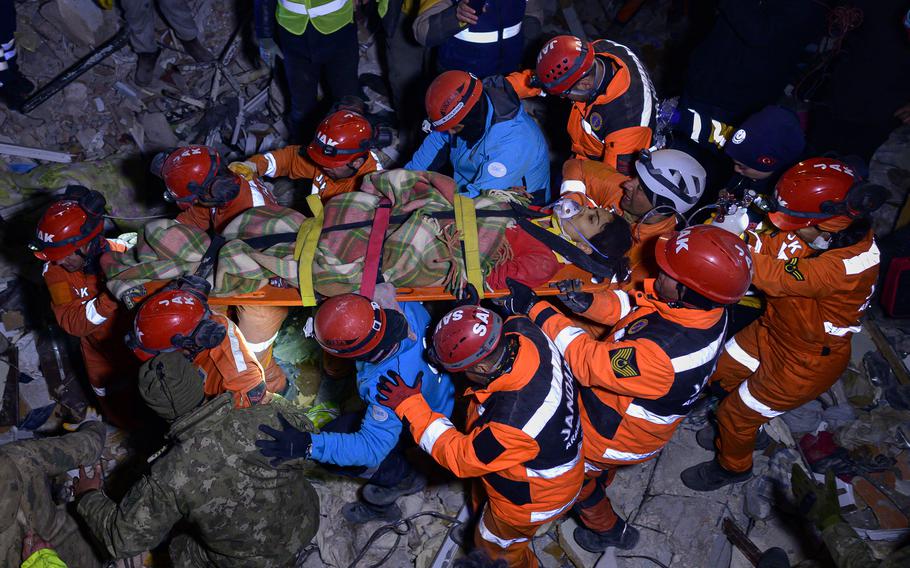
Ece Koseoglu, 25, is placed on a stretcher by rescuers after being removed from under the rubble of a collapsed building following two massive back-to-back earthquakes that affected Turkey and Syria, in Antakiya, Turkey, on Feb. 10, 2023. (Yasin Akgul, AFP via Getty Images/TNS)
(Tribune News Service) — Tragedy has long haunted the broad swath of land where earthquakes have just claimed thousands of lives, left many thousands of people injured and plunged already impoverished millions into yet deeper financial despair.
For centuries, an angry earth has shaken communities in the sunbaked mountains and valleys that sprawl across southeastern Turkey. But the earth’s latest deadly roar comes at an especially vulnerable moment for Turkey and Syria, where an unusually bitter cold hourly seals the rubble and the earthquakes’ countless bodies.
This tragedy is not a distant one for me.
As a journalist, I have traveled along Turkey’s southeastern border and visited Syrian refugees and the places where they were living. But the deeper significance is that my wife and I, as Peace Corps volunteers, ran a small, meagerly supported orphanage for Turkish boys in a slum on the far edge of Istanbul more than five decades ago.
Many of the boys, at 6 years old and up, were the sole survivors of an earthquake in eastern Turkey. We used our Peace Corps salaries to buy the boys meat or fish one day of the week and pleaded with charities to provide clothes for them.
The enormous calamity confronts the two nations that have been equally struggling for some time to overcome massive economic crises and a lingering 12-year civil war in Syria that has made the country a pariah and sent millions of Syrians into exile in Turkey or independent pockets within the country. That includes a narrow scrap of land in northwestern Syria where they are huddled along the Turkish border and protected by fighters against the regime.
One of the places hit by the earthquake, this tiny haven is a remnant of a once-hopeful uprising that collapsed when Russia sent fighters and air power to rescue Syrian President Bashar Assad’s regime. Many of those living there have fled again and again, leaving all behind. At the peak of the fighting, the Russian-led air war was exceptionally cruel in targeting hospitals there and elsewhere, leaving few medical resources for today’s victims of the earthquake.
For those living in the regime-controlled areas, existence has similarly been difficult. Much of the nation’s infrastructure has been demolished. Many Syrians have succumbed to poverty, and the financially crippled regime has markedly reduced subsidies.
So, too, as Turkey rushes to move thousands to safe housing, set up emergency medical facilities in cities and distant villages, and lead a global race to pull lives from the rubble, it is pinned down by a daunting economic collapse. An inflation rate nearing 90% in the last year has crippled businesses and meant great sacrifices for working-class Turks to buy basics. In February 2021, the U.S. dollar was equal to seven Turkish lira. Today, it is about 18.
Turkey generously welcomed Syrians fleeing mayhem in their country, and the number eventually reached 3.6 million. Years later, many Syrians live in the earthquake area in whatever housing they can afford or the refugee camp network created when they first arrived. However, their welcome has waned as some Turks view them as competitors for jobs or burdens for a struggling Turkish economy. Southeastern Turkey is one of the nation’s poorest regions, one of the reasons large numbers of Turks have traditionally fled to large cities.
The history of earthquakes has also been the cruelest for Turks living in remote villages in mud homes or those made of similarly flimsy construction. But the quakes have also extracted heavy tolls in larger communities where construction precautions were not taken. That danger was theoretically swept aside by 2018 legislation that laid down new construction safety measures. But Turks have complained that the law has not been well enforced. Indeed, compelling video of the sudden collapse of a 14-story apartment building in Adana, a large city about 100 miles from the earthquake’s epicenter, makes clear the quake’s immense power and the precarious nature of housing for numbers of Turks.
And so, as before, I expect the survivors of this latest tragedy will most likely need far more than bandages and temporary housing to recover.
As will their nations.
Stephen Franklin is a former foreign correspondent and labor writer for the Chicago Tribune who has trained journalists in Africa, the Middle East and South Asia. He and his wife, Suzanne, were Peace Corps volunteers in Turkey.
©2023 Chicago Tribune.
Visit at chicagotribune.com.
Distributed by Tribune Content Agency, LLC.